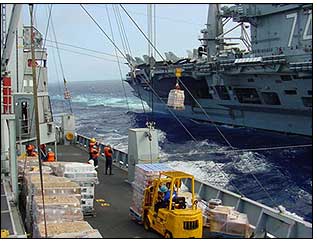Oct 28, 2004Although the U.S. Department of Defense’s official rollout of passive RFID won't begin until Jan. 1, the DOD is already seeing some benefits from its use of the technology at test facilities, says Kathy Smith, special assistant in the DOD's Office of Supply Chain Integration office.
Speaking at the Truth in Technologies 2004: RFID & Bar Codes Forum, held in Stony Brook, N.Y., last week, Smith said that the DOD is seeing improved asset visibility and more timely and accurate shipments through one of its freight consolidation centers. The DOD expects to be also able to pay suppliers more quickly because RFID systems will provide better information about what was delivered and when. The forum was organized by the AIDC 100, a not-for-profit organization of automatic identification and data capture professionals.
Most of the benefits are being seen at the Norfolk Ocean Terminal, a facility that provides a waterfront logistics support. At a freight consolidation station within the facility, the DOD is consolidating shipments of materiel bound for various overseas locations (see The DOD Begins RFID Rollout).
Staff at the terminal place items bound for different destinations overseas in different areas. In the past, it was hard to make sure that the right items were placed in the right containers and that they were indeed shipped to the right location. Now, cartons of meals ready to eat and other items are scanned as they are put on pallets, and the individual items are associated with a pallet that has its own RFID tag with a unique serial number. As the pallets are loaded into containers, they pass by fixed scanners and are read. Software is used to confirm that the right goods were put in the right container.
The DOD is phasing in RFID in stages. It will start by reading tags on shipments to two distribution centers run by the Defense Logistics Agency (DLA) and expand this to 32 other depots around the country (see DOD Releases Final RFID Policy). Gradually, passive readers will be deployed at depots overseas. "Ultimately, we are hoping we will get better consumption data," Smith said, referring to the use of materiel by soldiers in the field.
The DOD is working toward being ready to accept tagged shipments beginning in Jan. 1. At the two DLA distribution centers, the DOD is deploying readers and determining the optimal antenna configurations around dock doors to ensure pallet tags can be read accurately. "We are learning from the work we are doing with building pallets with tagged cases at the Ocean Terminal," Smith said. "We also need to get lessons learned on the incoming side, where we are not controlling the tag placement, and create guidelines for our suppliers."
Smith also said the DOD is working with the Office of Management and Budget to amend the Defense Federal Acquisition Regulations (DFARs), a set of rules that the government uses for military procurement contracts, so that relevant DOD contracts will require suppliers to place RFID tags on cases and pallets of goods they ship to military depots. The new rules should be published in about a month, she said.
The DOD also plans to amend the contracts’ electronic data interchange (EDI) requirements in order to ensure that the advance shipping notices (ASNs) it receives can handle RFID serial numbers. Suppliers will read a case’s RFID tag as they place the case on a pallet and associate the case’s tag with the pallet’s tag. That data will then be forwarded to the DOD, so it can match information in the ASN with what's received at its facilities. "ASNs are critical to our success," Smith said. "That's where we turn data into knowledge."
She admitted that some of the DOD's legacy computer systems wouldn't be able to handle unique serial numbers, but she said that the DOD would rely on middleware to filter data and manage the association of cases with pallets and pallets with containers, which will have active RFID tags, and then pass that data to the legacy systems in a format they can handle.
Smith also said that the DOD would do Hazards of Electromagnetic Radiation to Ordnance (HERO) testing to ensure that passive systems won't accidentally detonate explosives. "We're going through the universe of items that we buy to see what needs HERO testing," she said. "It's really a matter of what the stand-off distance is going to be."
The standoff distance is the distance readers must be kept from items that could explode. Currently, active-tag readers must be at least 1 foot from ordinance, but the DOD has not determined the minimum distance for passive-tag readers, which must emit more energy than active-tag readers do in order to power up passive tags.


